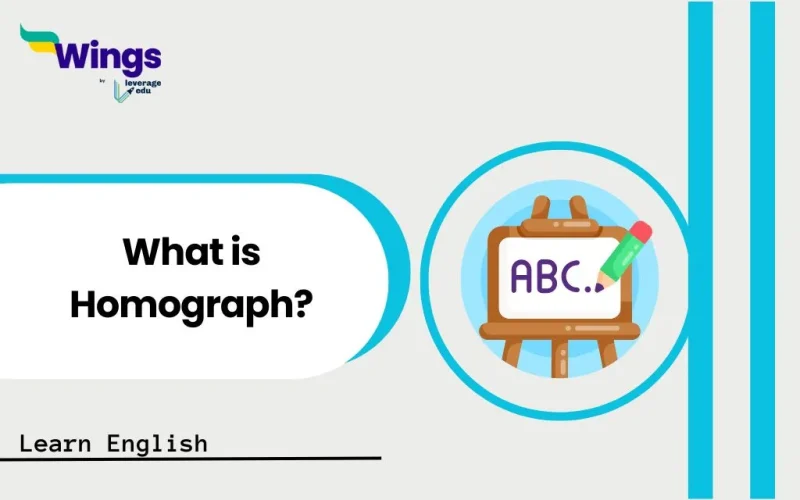What is Homograph: ‘Can you get me a can of water?’ Have you ever come across words like ‘can’ that look the same but have completely different meanings? Well, these intriguing words are called homographs. To put it in simple words, homographs are words that share the same spelling but differ in meaning and sometimes pronunciation. Understanding homographs is essential for precise communication and a deeper appreciation of the English language’s nuances.
As you continue reading this blog post, you will learn what is homograph. Also, you will explore common examples and understand how to differentiate their meanings.
This Blog Includes:
What is Homograph?
What is homograph? A homograph is a word that is spelt the same as another word but has a different meaning. Often, though not always, homographs also have different pronunciations. This phenomenon adds a layer of complexity and richness to the English language.
As for the origin of the word, the prefix homo- comes from the Greek word for “same,” and graph comes from the Greek word for “writing”; homographs are written—spelt—the same way.
Let us look at some of the examples of homographs to get a better understanding.
| Homograph | Meaning 1 | Meaning 2 |
| Bat | I saw a bat flying at night. | He hit the ball with a bat. |
| Can | I can lift that box. | Please put the soda in the can. |
| Park | The children played in the park. | I will park the car here. |
| Bow | She tied a bow in her hair. | The actor took a bow. |
| Rose | She received a red rose. | The sun rose this morning |
Also Read: What are Homophones?
20 Common Homograph Examples with Sentences
In our journey to learn what is homograph, we must also learn about common examples. Let us now look at some of the common homograph examples along with the sentences for your better understanding:
| Homograph | Meaning 1 | Sentence Example | Meaning 2 | Sentence Example |
| Bat | Animal | A small bat flew out of the cave. | Sports equipment | He swung the bat and hit a home run. |
| Bow | To bend | The ballerina took a graceful bow. | Front of a ship | The bow of the ship cut through the waves. |
| Close | To shut | Please close the door gently. | Near | They live very close to the market. |
| Desert | Arid region | The desert is a very dry place. | To abandon | They decided to desert the abandoned house. |
| Minute | 60 seconds | Wait just a minute, please. | Very small | The details were minute and hard to see. |
| Lead | Metal | The pipes were made of lead. | To guide | She will lead the team to victory |
| Tear | Water from the eye | A tear rolled down her cheek. | To rip | Be careful not to tear the paper. |
| Wind | Moving air | The wind is blowing strongly today. | To turn | Please wind the clock before bed. |
| Park | Recreational Area | The children played in the park. | To stop a vehicle | He will park the car in the garage. |
| Rose | Flower | She receives a beautiful red rose. | To come up | The sun rose early this morning. |
| Right | Correct | You are absolutely right. | Direction | Turn right at the next intersection. |
| Fair | Just | The judge made a fair decision. | Event | They went to the country fair. |
| Bank | Financial Institution | She deposited money at the bank. | Edge of a river | They sat on the river bank. |
| Present | Gift | She received a lovely birthday present. | To show | The teacher will present the award. |
| Record | Vinyl disk | She listened to her favourite record. | To register | They will record the meeting. |
| Object | Thing | That is a strange object. | To disagree | I object to that statement. |
| Produce | To create | The farm will produce many vegetables. | Fruits and vegetables | They bought fresh produce at the market. |
| Spring | Season of the year | Spring is my favourite season. | To jump | The cat can spring across the room. |
| Content | The information within | The content of the book was very informative | Satisfied | He was content with his simple life. |
| Wave | Water movement | The waves crashed against the shore. | Hand gesture | She gave a friendly wave. |
Read more on Difficult Homonyms with Examples
Homographs with Pronunciation Differences
Homographs are words that share the same spelling but have different meanings and, in some cases, different pronunciations. This can lead to confusion, especially for language learners, as the context often dictates how a homograph is pronounced.
Let us look at the following examples of homographs which are pronouns differently based on their meanings:
| Homograph | Meaning 1 | Pronunciation 1 | Meaning 2 | Pronunciation | Example Sentence 1 | Example Sentence 2 |
| Lead | Heavy metal | /lɛd/ | To guide | /liːd/ | The pipes are made of lead. | Se will lead the team. |
| Wind | Moving air | /wɪnd/ | To turn, cool | /waɪnd/ | The wind is blowing strongly. | Wind the clock, please. |
| Close | Near | /kloʊs/ | To shut | /kloʊz/ | They live close to the store. | Please close the door. |
| Tear | Liquid from eye. | /tɪər/ | To rip | /tɛər/ | A tear fell from her eye. | Don’t tear the paper. |
| Minute | 60 seconds | /ˈmɪnɪt/ | Very small | /maɪˈnjuːt/ | Wait a minute | The details were minute. |
| Present | Gift | /ˈprɛzənt/ | To show | /prɪˈzɛnt/ | I received a present. | He will present the award. |
Homographs vs Homophones vs Homonyms: Key Differences
Now that we know what is homograph, let us understand the distinctions between homographs, homophones and homonyms. Knowing about these differences can greatly contribute to helping one improve their grasp of the English language. Below is a breakdown of the key differences between homographs, homophones and homonyms based on different parameters.
| Feature | Homophones | Homographs | Homonyms |
| Definition | Words that sound the same but have different spellings and meanings. | Words that are spelled the same but have different meanings, and sometimes different pronunciations. | Words that are spelt and pronounced the same but have different meanings. |
| Spelling | Different | Same | Same |
| Pronunciation | Same | Sometimes Different | Same |
| Meaning | Different | Different | Different |
| Examples | to/too/two, there/their/they’re, sea/see | lead (metal)/lead (to guide), bow (to bend)/bow (front of a ship), tear (to rip)/tear (water from the eye) | bank (financial institution)/bank (river’s edge), bat (animal)/bat (sports equipment), fair (just)/fair (event) |
Read more on Homophone vs Homonyms vs Homograph
How to Master Homographs?
Take a look at this comprehensive approach to help you confidently navigate these tricky words:
1. Build a Strong Foundation: To understand homographs, begin by understanding the definition of the word, along with its different meanings and pronunciations. Upon understanding, you will be able to differentiate between homographs, homophones, and homonyms. This will prevent confusion.
2. Develop Effective Learning Strategies: To make learning homographs interesting, you must adopt interesting methods to make learning fun. Some of the best ways are as follows:
- Make a homograph list, flashcards, and read books, articles and materials regularly. Pay attention to how words are used in different contexts.
- You can also make use of the dictionary (both print and online). Look up unfamiliar words and pay attention to their multiple meanings and pronunciations.
- Don’t forget to put your learning to use. You must attempt to do exercises or create your own to practice identifying the correct meaning of homographs in sentences.
- For homographs with differing pronunciations, practice saying the words out loud. Use online resources that provide audio pronunciations.
- Create your own sentences using homographs with their different meanings. This will solidify your understanding.
3. Implement Consistent Practice: Review your homograph list and flashcards regularly to reinforce your learning. Pay attention to homographs in your everyday conversations and reading. You can also indulge in playing word games like Scrabble, crosswords, or word puzzles that challenge your vocabulary.
By combining these strategies and maintaining a consistent practice, you can significantly improve your ability to understand and use homographs correctly.
Also Read: Difficult Words with Meaning in English Vocabulary
Homograph Practice Exercises
After you have the answer to what is homograph, it is time to put your knowledge into practice. Below we have provided you with 5 exercises to practice. You will also find answers to all the questions in the end.
Exercise 1: Fill in the Blanks
Instructions: Choose the correct meaning of the homograph to complete each sentence.
- I need to ________ the clock before it stops. (wind)
- a) moving air
- b) to turn
- She wiped a ________ from her eye. (tear)
- a) to rip
- b) liquid from the eye
- They decided to ________ the old building. (desert)
- a) arid region
- b) to abandon
- The details on the watch were very ________. (minute)
- a) 60 seconds
- b) very small
- He will ________ the award to the winner. (present)
- a) a gift
- b) to show
Check Answers:
- b) To turn
- b) Liquid from the eye
- b) To abandon
- b) Very small
- b) To show
Exercise 2: Sentence Creation
Instructions: Create two sentences using the given homograph, each with a different meaning.
- Bat
- Can
- Right
- Fair
- Spring
Possible Answers:
- Bat:
- The bat flew out of the cave.
- He swung the bat at the baseball.
- Can:
- I can lift that box.
- Please put the juice in the can.
- Right:
- You are absolutely right.
- Turn right at the corner.
- Fair:
- The judge made a fair decision.
- We went to the county fair.
- Spring:
- Spring is my favourite season.
- The cat can spring across the room.
Explore similar blogs from Learn English!
FAQs
A homograph is a word that is spelt the same as another word but has a different meaning.
Sometimes, homographs also have different pronunciations.
Homographs: Same spelling, different meanings (and sometimes different pronunciations).
Homophones: Same pronunciation, different spellings and meanings.
“Homonym” is a broader term. It includes both homographs (same spelling) and homophones (same sound). So, all homographs and homophones are homonyms.
Understanding homographs helps improve reading comprehension and prevent misunderstandings in communication. Context is crucial for determining the correct meaning.
Yes, homographs are often used in puns and other forms of wordplay because their multiple meanings can create humorous or clever effects.
We hope this blog on “What is Homograph” helped you improve your English skills. You can also follow the Learn English page of Leverage Edu for more exciting and informative blogs related to English grammar and the English language.
 One app for all your study abroad needs
One app for all your study abroad needs















 60,000+ students trusted us with their dreams. Take the first step today!
60,000+ students trusted us with their dreams. Take the first step today!

